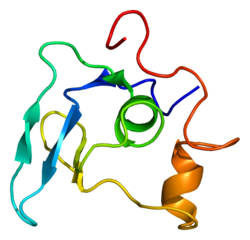Fibrilina 1
gene da espécie Homo sapiens
(Redirecionado de FBN1)
Fibrilina 1 ou FBN1 é uma proteína que em humanos é codificada pelo gene FBN1, localizado no cromossomo 15.[1][2]

Este gene codifica um membro da família da fibrilina. A proteína codificada é uma glicoproteína grande da matriz extracelular que serve como componente estrutural de microfibrilhas. Estas microfibrilhas providenciam suporte estrutural em tecidos conectivos elásticos e não-elásticos, por todo o corpo. Mutações neste gene estão associadas com a síndrome de Marfan, ectopia lentis isolada, a síndrome de Weill-Marchesani e a síndrome de Shprintzen-Goldberg.[3]
Referências
- ↑ Biery, N J; Eldadah, Z A; Moore, C S; et. al (15 de fevereiro de 1999). «Revised genomic organization of FBN1 and significance for regulated gene expression». Genomics. 56 (1): 70–7. PMID 10036187. doi:10.1006/geno.1998.5697. Consultado em 22 de novembro de 2020
- ↑ Faivre, L; Gorlin, R J; Wirtz, M K; et al. (Janeiro de 2003). «In frame fibrillin-1 gene deletion in autosomal dominant Weill-Marchesani syndrome». Journal of Medical Genetics. 40 (1): 34–6. PMC 1735272 . PMID 12525539. doi:10.1136/jmg.40.1.34. Consultado em 22 de novembro de 2020
- ↑ «Entrez Gene: FBN1 fibrillin 1»
Leitura adicional editar
- Hayward C, Brock DJ (1998). «Fibrillin-1 mutations in Marfan syndrome and other type-1 fibrillinopathies.». Hum. Mutat. 10 (6): 415–23. PMID 9401003. doi:10.1002/(SICI)1098-1004(1997)10:6<415::AID-HUMU1>3.0.CO;2-C
- Robinson PN, Godfrey M (2000). «The molecular genetics of Marfan syndrome and related microfibrillopathies.». J. Med. Genet. 37 (1): 9–25. PMID 10633129. doi:10.1136/jmg.37.1.9
- Handford PA (2001). «Fibrillin-1, a calcium binding protein of extracellular matrix.». Biochim. Biophys. Acta. 1498 (2-3): 84–90. PMID 11108952
- Robinson PN, Booms P, Katzke S; et al. (2002). «Mutations of FBN1 and genotype-phenotype correlations in Marfan syndrome and related fibrillinopathies.». Hum. Mutat. 20 (3): 153–61. PMID 12203987. doi:10.1002/humu.10113
- Adès LC, Holman KJ, Brett MS; et al. (2004). «Ectopia lentis phenotypes and the FBN1 gene.». Am. J. Med. Genet. A. 126 (3): 284–9. PMID 15054843. doi:10.1002/ajmg.a.20605
- Milewicz DM, Dietz HC, Miller DC (2005). «Treatment of aortic disease in patients with Marfan syndrome.». Circulation. 111 (11): e150–7. PMID 15781745. doi:10.1161/01.CIR.0000155243.70456.F4
- Boileau C, Jondeau G, Mizuguchi T, Matsumoto N (2005). «Molecular genetics of Marfan syndrome.». Curr. Opin. Cardiol. 20 (3): 194–200. PMID 15861007. doi:10.1097/01.hco.0000162398.21972.cd
- Whiteman P, Hutchinson S, Handford PA (2006). «Fibrillin-1 misfolding and disease.». Antioxid. Redox Signal. 8 (3-4): 338–46. PMID 16677079. doi:10.1089/ars.2006.8.338